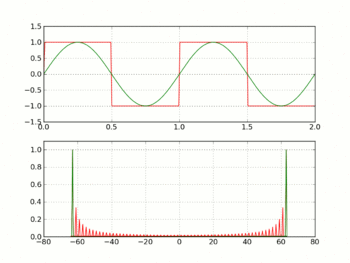My project needs to drive a medium power ultrasonic piezoelectric transducer from a sine wave (/ sawtooth) sweep generator that sweeps +/- 2% of the transducer resonant frequency.
The question: What are my simplest options for driving these transducers from a DDS generated shaped signal, with reasonably low distortion (5-10%)?
- Use a power amplifier IC off a higher voltage rail, with lots of heat sinking, to directly drive the transducer
- Use a power amplifier IC, then (?) a transistor current amplification stage, then an appropriate (need help identifying) step-up transformer to drive the transducer
- Use some sort of (need help identifying) class D high power amplifier IC that would not need much heat sinking (Edit: Not a solution, see Note 7).
- Some other option entirely
- Edit: From suggestion below Identify an off the shelf OEM amplifier module that meets the parameters and constraints.
UPDATE: [15-Oct-2012] Option 5 above seems best answer, if a suitable OEM module or two could be pointed out – None found in my research so far. Hence leaving question open.
The sweep waveform generation is through a DDS IC, AD9850, Datasheet here: AD9850 CMOS 125 MHz Complete DDS Synthesizer
One of the transducers available to me: 5938D-25LBPZT-4 (Ultrasonic Langevin Transducers)
- Resonant frequency: 25 KHz
- Resonant impedance: 10-20 Ohms
- Capacitance: 5400 pf +/-10%
- Input power: 60W
- Datasheet: I wish I could find one!
The transducer would change case to case, from 20KHz to 135KHz, each in the 50-250 watt range, similar in design to the one above.
The driver designs I have seen for these transducers typically use switching i.e. square waves to drive them, MOSFET driven, with Vpp 100v in some cases! (Do these devices even need that kind of voltage? Edit: Evidently so)
Some drivers use tuned filters to shape the waveform to a sine or approximation thereof.
This does not work for my purposes, unfortunately – The project is a single device that would first detect the resonant frequencies of an attached transducer across the full range 20-135KHz, then sweep around each resonant frequency with first a sine wave, (Edit: Removing this requirement as unfeasible: then a sawtooth signal,) at a specified power output, usually around half the rated power of the transducer.
So what I am looking for is the wisdom of this community in suggesting a suitable prototype-friendly approach to getting those DDS waveforms over to the transducer. Thank you all!
Added some notes based on comments and responses received:
- Waveform accuracy is not super-critical, 5% distortion is very acceptable. Thermal issues and power wastage through dissipation in the amplifier stage are bigger concerns. Cost is a key concern, at least until past the prototype stage.
- It has been suggested that prebuilt OEM amplifier modules that suit the requirements might be my best bet. While that does appeal, I am still hoping for alternatives in addition to, and examination of, the options I have proposed in my question, hence not marking the answer accepted, yet.
- Not found any OEM module online yet which covers a 20KHz to 135KHz frequency range, even for 50 watt output. The one suggested in a response is designed for 3.5KHz, and its switching frequency is 100KHz. (Dropped this requirement: Also, wouldn't I require bandwidth much higher than that, to handle a sawtooth wave with even cursory accuracy? I might have to skip the sawtooth requirement, and constrain my question to sine waves, if the sawtooth or other arbitrary waveform delivery is seen by respondents as unattainable at reasonable cost.)
- New Suggested approach is a Class B with feedback. Caveat mentioned is high dissipation at this amplifier stage. So two adjuncts to my question:
- Is there a monolithic Class B amplifier IC that might cover the desired frequency range (20KHz to 135KHz, giving up on the sawtooth wave) and power requirements (50 watts max)?
- What is the range of heat dissipation expected at such a class B stage, as a percentage of expected power delivery to transducer?
- New About Class D amplifiers, monolithic or OEM: They would need to use switching frequencies of the order of 800KHz or higher, to support a 100-135KHz sine wave with reasonable THD. For a 5% distortion requirement, the switching frequency must be even higher. Such high switching frequency Class D power amplifiers do not seem to exist.


Best Answer
Try these linear amplifiers made by Apex. They are designed specifically for ultrasound aplications.